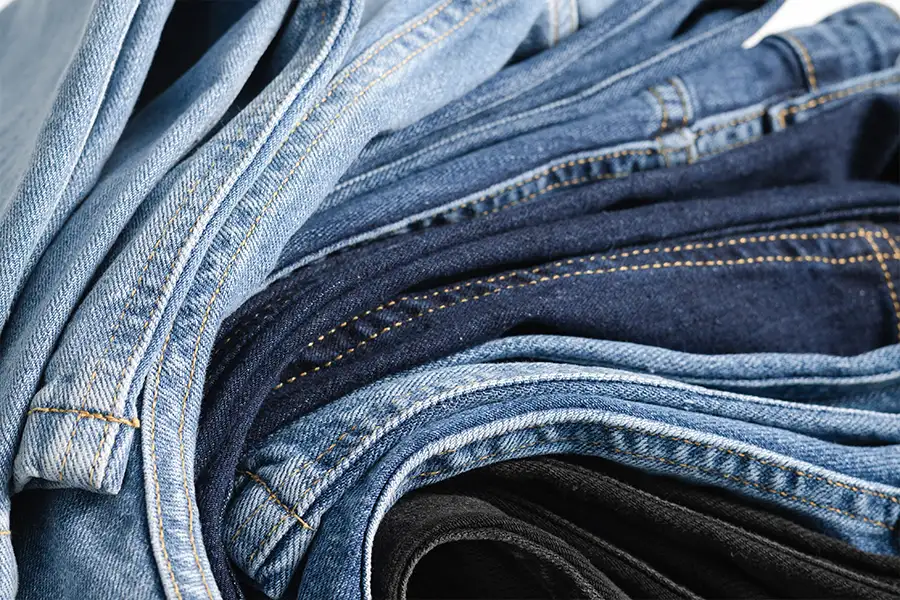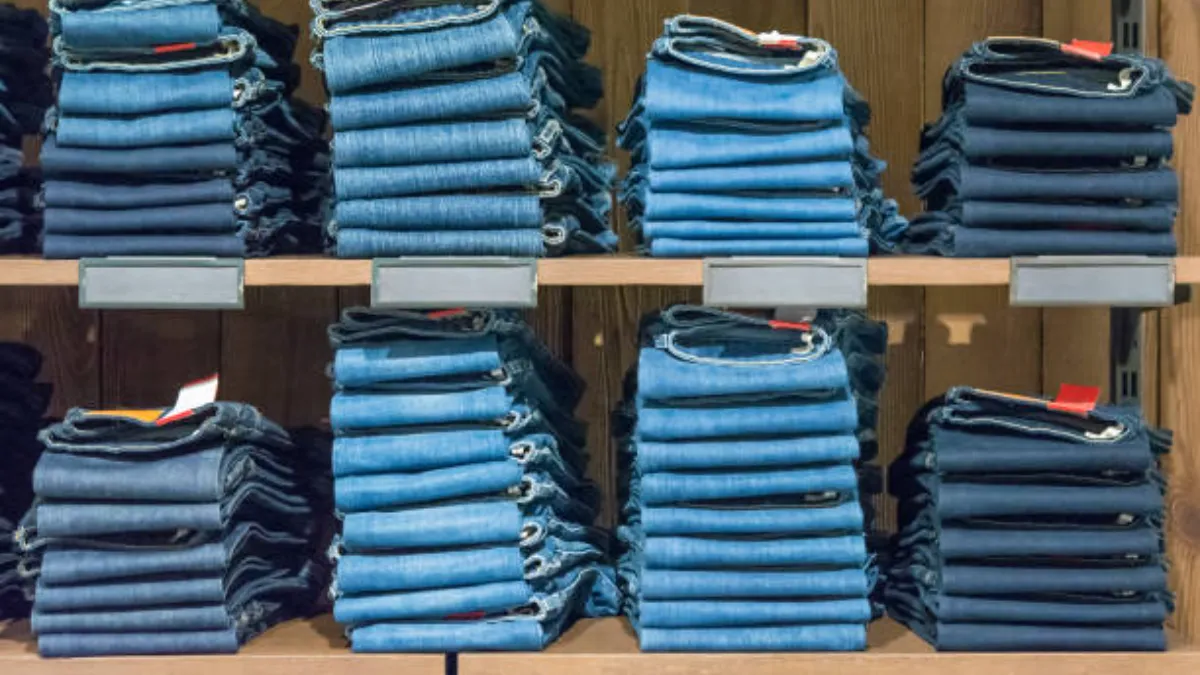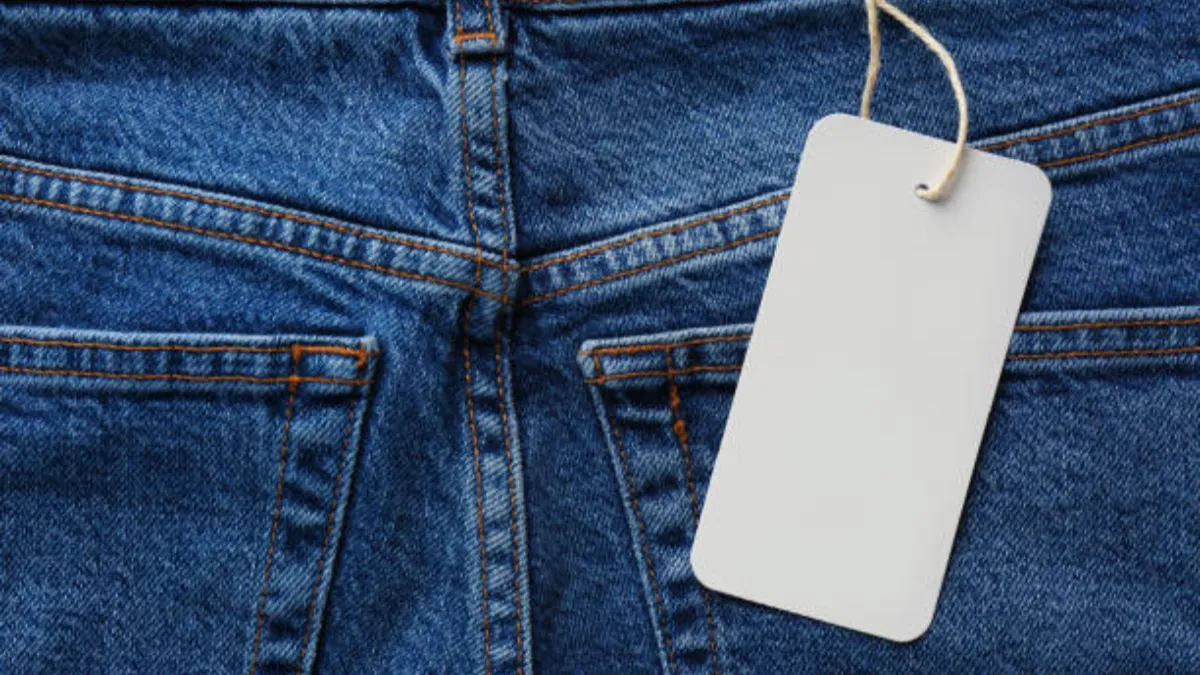For apparel manufacturers and logistics leads, jean weight can directly impact margins, freight costs, وتحديد المواقع العلامة التجارية. This guide shows how fabric weight, كثافة نسج, and design choices affect durability, راحة, and shipping efficiency. It compares GSM with ounces, outlines critical weight categories, and pinpoints what to address in production and freight planning to keep your supply chain lean, reliable, and aligned with target customer expectations.
Why Understanding Jean Weight Matters for Brands and Logistics
In jean production, fabric selection, construction methods, and design details all influence garment weight and the overall sourcing and delivery cost model.
For clothing brands, choosing the right fabric weight helps match your market: lightweight denim for seasonal fashion, midweight for daily wear, and heavyweight for premium or workwear collections.
For logistics teams, accurate jean weight data ensures predictable freight costs and avoids overpacking issues in bulk transport.
Quick Answer: Average Jeans Weight
Most jeans weigh between 1.2 و 2.5 pounds (0.55–1.15 kg) per pair, depending on fabric thickness and size.
Lightweight denim (under 12 أوز) offers softness and breathability, while heavyweight denim (16 أوز وما فوق) provides superior durability and structure—ideal for workwear or premium jeans.
| Denim Type | وزن (أوقية/ياردة²) | Typical Use |
|---|---|---|
| خفيف الوزن | 5-10 أوقية | Summer jeans, trend pieces |
| الوزن المتوسط | 11–15 oz | الجينز اليومي, classic fits |
| الوزن الثقيل | 16–32 oz | الدنيم الخام, ملابس العمل, premium collections |
What Factors Affect the Weight of Jeans

Several design and material elements contribute to how much a pair of jeans weighs. Understanding these factors helps manufacturers balance cost, متانة, and comfort.
Fabric Composition
Review fiber blends early in the procurement process. 100% الدنيم القطن is typically heavier than blends with elastane or polyester, which reduce mass and increase stretch.
- 100% قطن الدنيم – Heavier, rigid, and highly durable. Ideal for raw or heritage lines.
- تمديد الدنيم (القطن + الإيلاستين) – Lighter and flexible, preferred for slim or women’s fits.
- Blended Fabrics (القطن + البوليستر) – Lower weight, wrinkle-resistant, and faster to dry.
Weave Density and Yarn Thickness
Denim is woven using twill construction.
- Tighter weaves use more yarn per inch, increasing weight and stiffness.
- Thicker yarns create rugged, structured fabric ideal for heavy-duty jeans.
- Lighter twills use finer yarns for a soft hand feel, reducing total garment weight.
Design Features and Hardware
- Every added detail changes total weight:
- Extra pockets, lining, or embroidery = +20–50g
- Metal rivets, أزرار, and zippers = +30–100g
- Reinforced seams or double stitching = +3–5% increase per garment
How Denim Weight is Measured (GSM vs. Ounces)

Denim weight is commonly measured in ounces per square yard (أوقية/ياردة²) or grams per square meter (GSM).
1 oz/yd² ≈ 33.9 GSM
| Denim Type | Ounces | GSM (Approx.) |
|---|---|---|
| خفيف الوزن | 5-10 أوقية | 170–340 GSM |
| الوزن المتوسط | 11–15 oz | 370–510 GSM |
| الوزن الثقيل | 16–32 oz | 540–1080 GSM |
دنيم مخصص مصمم خصيصًا لرؤية علامتك التجارية
Partner with Changhong to create premium denim collections crafted with deep customization and sustainable practices. From fabric choices to finishes, enjoy flexible, low MOQ solutions backed by two decades of industry expertise and end-to-end quality control.

Denim Weight Examples from Major Brands

| Brand | Denim Weight | ملحوظات |
|---|---|---|
| ليفي 501 | ~14 oz | Classic midweight denim, balanced comfort and durability |
| Iron Heart | 18–21 oz | Heavyweight raw denim, strong fading potential |
| Gustin | 16–22 oz | Premium selvedge with rugged performance |
| Fast-Fashion Labels | 9–11 oz | Lighter stretch denim for comfort and low-cost shipping |
Are There Any Differences Between the Weight of Men’s vs. Women’s Jeans?

The difference in weight between الجينز الرجالي والنسائي comes from several factors, including fabric choice, ملائم, and design details.
Men’s jeans are typically made from thicker, heavier denim to provide durability and structure. They often feature deeper pockets, reinforced seams, and larger hardware, all of which add extra grams to the final garment.
الجينز النسائي, على الجانب الآخر, usually prioritize flexibility and comfort. Many styles use stretch denim blends, lighter fabrics, and slimmer cuts. These choices reduce overall weight while maintaining the shape and fit women expect. Decorative elements, pocket size, and seam reinforcement are also generally lighter or minimized, further decreasing the total weight.
| جنس | Weight Range (أوز) | ملحوظات |
|---|---|---|
| Men’s Jeans | 12-20 أوز | Thicker denim, reinforced seams, deeper pockets |
| Women’s Jeans | 8-14 أوز | Lighter denim, stretch blends, slimmer cuts |
How to Measure the Weight of Your Jeans
If your jeans’ weight isn’t labeled, you can estimate it using simple tools.
- Check the Label: Some manufacturers print “12 oz denim” or similar specs.
- Use a Scale: A typical kitchen or postal scale works well.
- Lightweight jeans: 0.8–1.0 lbs
- Midweight jeans: 1.0–1.5 lbs
- Heavyweight jeans: 1.6–2.5 lbs
- Compare by Feel: Rigid jeans with thick folds are likely above 14 أوز; soft jeans usually fall under 11 أوز.
How Jean Weight Influences Shipping Costs
Most jeans weigh between 1.5–2 pounds (700–900 grams), but heavier fabrics or added hardware can push this to 1.0–1.5 kilograms (2.2–3.3 pounds). Measured in ounces per square yard, denim weight impacts shipment volume and freight charges. Lightweight denim under 12 ounces enables denser packing and reduces per‑unit costs, while heavyweight denim above 16 ounces limits container capacity. Larger sizes and decorative elements add mass, making precise weight data essential for accurate budgets. Logistics teams should request confirmed weights from suppliers during sampling, then model transport scenarios to keep freight spend aligned with forecasts and container space fully optimized.
The Effect of Jean Weight on Warehousing Strategies
Heavier jeans require stronger shelving and pallets, reducing units per location and impacting inventory density. If layouts assume standard weights, unexpected fabric or design changes can force re‑racking or aisle adjustments. Heavier stock also shifts handling procedures—mechanical assistance may be needed, and packaging may require reinforcement. By integrating weight considerations into forecasting and slotting, brands can sustain warehouse efficiency, prevent distribution bottlenecks, and keep costs predictable while meeting customer expectations for fit and quality.
How Can You Optimize Denim Weight to Reduce Costs and Boost Customer Appeal?
Selecting the right قماش الدنيم weight is a strategic decision that impacts material spend, production speed, customer satisfaction, and profit margins. For apparel manufacturers and sourcing managers, the objective is to match fabric weight to production capabilities, market positioning, and supply chain efficiency without eroding margins. This section outlines the operational and market variables to assess before finalizing fabric specifications.
Material Cost Impact of Denim Weight
Heavier denim requires more cotton, dye, and chemicals—often 60–70% of manufacturing costs—making commodity price fluctuations immediately visible in profit reports. Cutting waste compounds expenses, especially with dense fabrics. Lighter weights reduce raw input costs and freight per unit, enabling more competitive and flexible retail pricing.
Production Efficiency and Fabric Utilization
Thick denim slows production, demands stronger machinery, and raises risks of defects that require additional quality control. Matching fabric thickness to line capacity and optimizing pattern layouts to minimize waste are essential to maintain throughput and avoid delivery bottlenecks.
Customer Preferences and Market Segmentation
Denim at 8–10 oz suits warm climates and style-focused collections, while weights of 12 oz or more cater to workwear and durability-oriented buyers. Use market data to align fabric weight with segment expectations, ensuring appeal without compromising brand positioning.
Logistics and Supply Chain Cost Considerations
Extra ounces increase global shipping costs and warehouse space requirements. Incorporating fabric weight into supply chain planning helps control landed costs and safeguard margins in export markets.
Balancing Profit Margins with Fabric Weight Choice
Denim weight directly influences costs, التسعير, والربحية. Validate choices with cost analysis and consumer trend data before scaling orders to protect margins and avoid inventory mismatches with market demand.
الأسئلة الشائعة
How Many Pounds Do Jeans Weigh?
Most jeans weigh between 1 و 2.5 pounds (0.45–1.13 kg) per pair. The exact weight depends on fabric type, size, ملائم, and additional hardware like rivets and buttons.
How Heavy Is an Average Pair of Jeans?
The average pair of jeans usually weighs around 1.2–1.5 pounds (0.55–0.68 kg), with midweight denim being the most common choice for everyday wear.
How Much Do Levi 501 Jeans Weigh?
ليفي 501 جينز are made from midweight denim, typically around 14 أوقية لكل ساحة مربعة, which translates to roughly 1.2–1.5 pounds (0.55–0.68 kg) per pair, depending on size.
How Much Do Hollister Jeans Weigh?
Hollister jeans often use lighter stretch denim, usually around 10–12 oz per square yard, which is approximately 0.9–1.2 pounds (0.41–0.55 kg) per pair.
How Much Do Men’s Jeans Weigh?
Men’s jeans are generally heavier due to thicker denim and reinforced seams, averaging 12–20 oz per square yard, or about 1.2–2 pounds (0.55–0.9 kg) per pair.
How Much Do Women’s Jeans Weigh?
Women’s jeans are usually lighter, often made with stretch fabrics and slimmer cuts. They typically weigh 8–14 oz per square yard, or about 0.8–1.5 pounds (0.36–0.68 kg) per pair.
How Much Do Jeans Weigh for Shipping?
For shipping purposes, most jeans weigh between 1 و 2.5 pounds (0.45–1.13 kg) per pair. Lighter denim allows more units per carton, while heavier workwear or raw denim can increase freight costs.






